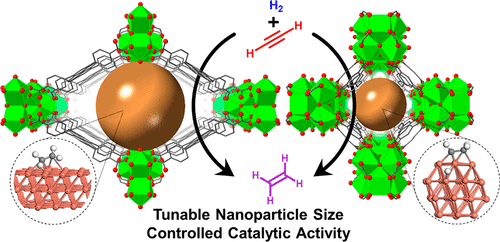当前位置:
X-MOL 学术
›
Chem. Mater.
›
论文详情
Our official English website, www.x-mol.net, welcomes your feedback! (Note: you will need to create a separate account there.)
Precise Control of Cu Nanoparticle Size and Catalytic Activity through Pore Templating in Zr Metal–Organic Frameworks
Chemistry of Materials ( IF 8.6 ) Pub Date : 2020-03-27 , DOI: 10.1021/acs.chemmater.0c00059 Mohammad Rasel Mian 1 , Louis R. Redfern 1, 2 , Saied Md Pratik 3 , Debmalya Ray 3 , Jian Liu 1 , Karam B. Idrees 1 , Timur Islamoglu 1 , Laura Gagliardi 3 , Omar K. Farha 1
Chemistry of Materials ( IF 8.6 ) Pub Date : 2020-03-27 , DOI: 10.1021/acs.chemmater.0c00059 Mohammad Rasel Mian 1 , Louis R. Redfern 1, 2 , Saied Md Pratik 3 , Debmalya Ray 3 , Jian Liu 1 , Karam B. Idrees 1 , Timur Islamoglu 1 , Laura Gagliardi 3 , Omar K. Farha 1
Affiliation

|
Composite materials composed of nanoparticles trapped within metal–organic frameworks (MOFs) combine the broad functionality of nanotechnology with the structural regularity of crystalline scaffolds. Still, leveraging the tunability of MOF pore sizes to control nanoparticle diameter and spatial arrangement in these composites remains a great challenge. Here we present two Zr-based MOFs, NU-901 and NU-907, with distinct pore diameters that serve as templates for the controlled growth of Cu nanoparticles (CuNPs) of different sizes (∼1.5 nm and ∼0.9 nm, respectively). In situ synchrotron X-ray scattering and diffraction experiments, along with pair distribution function and difference envelope density analyses, provide crucial insight into the size and location of these CuNPs in the pores of each MOF. These composites (denoted as CuNPs@NU-901 and CuNPs@NU-907) are shown to be competent catalysts for the selective hydrogenation of acetylene to ethylene, with a clear structure–property relationship indicating that larger CuNPs exhibit higher activity than smaller particles. This counterintuitive trend is further explored using density functional theory calculations of transition state energies to understand the role of CuNP structure on catalytic functionality. The calculations show that the activation energy for semihydrogenation is higher for a Cu cluster of finite size than for a Cu surface. This work demonstrates the utility of templated nanoparticle growth within MOF pores as a general strategy to achieve precise control over the composite structure and functionality.
中文翻译:

通过Zr金属-有机骨架中的孔模板精确控制Cu纳米粒子的大小和催化活性
由被困在金属有机框架(MOF)中的纳米颗粒组成的复合材料将纳米技术的广泛功能与结晶支架的结构规则性结合在一起。尽管如此,如何利用MOF孔径的可调性来控制这些复合材料中的纳米颗粒直径和空间排列仍然是一个巨大的挑战。在这里,我们介绍了两种基于Zr的MOF,即NU-901和NU-907,它们具有不同的孔径,可作为模板来控制不同尺寸(分别为约1.5 nm和约0.9 nm)的铜纳米颗粒(CuNP)的生长。原位同步加速器X射线散射和衍射实验,以及成对分布函数和差异包膜密度分析,为每个MOF孔中这些CuNP的大小和位置提供了至关重要的见解。这些复合材料(分别表示为CuNPs @ NU-901和CuNPs @ NU-907)是乙炔选择性加氢成乙烯的有效催化剂,具有清晰的结构-性质关系,表明较大的CuNPs表现出比较小的颗粒更高的活性。使用过渡态能量的密度泛函理论计算来进一步探索这种违反直觉的趋势,以了解CuNP结构对催化功能的作用。计算表明,有限尺寸的铜簇的半氢化活化能比铜表面的高。这项工作证明了MOF孔中模板化纳米颗粒生长的实用性,作为实现对复合结构和功能的精确控制的一般策略。
更新日期:2020-03-27
中文翻译:

通过Zr金属-有机骨架中的孔模板精确控制Cu纳米粒子的大小和催化活性
由被困在金属有机框架(MOF)中的纳米颗粒组成的复合材料将纳米技术的广泛功能与结晶支架的结构规则性结合在一起。尽管如此,如何利用MOF孔径的可调性来控制这些复合材料中的纳米颗粒直径和空间排列仍然是一个巨大的挑战。在这里,我们介绍了两种基于Zr的MOF,即NU-901和NU-907,它们具有不同的孔径,可作为模板来控制不同尺寸(分别为约1.5 nm和约0.9 nm)的铜纳米颗粒(CuNP)的生长。原位同步加速器X射线散射和衍射实验,以及成对分布函数和差异包膜密度分析,为每个MOF孔中这些CuNP的大小和位置提供了至关重要的见解。这些复合材料(分别表示为CuNPs @ NU-901和CuNPs @ NU-907)是乙炔选择性加氢成乙烯的有效催化剂,具有清晰的结构-性质关系,表明较大的CuNPs表现出比较小的颗粒更高的活性。使用过渡态能量的密度泛函理论计算来进一步探索这种违反直觉的趋势,以了解CuNP结构对催化功能的作用。计算表明,有限尺寸的铜簇的半氢化活化能比铜表面的高。这项工作证明了MOF孔中模板化纳米颗粒生长的实用性,作为实现对复合结构和功能的精确控制的一般策略。


























 京公网安备 11010802027423号
京公网安备 11010802027423号